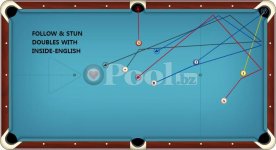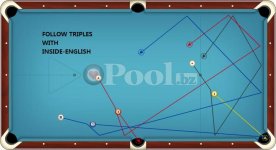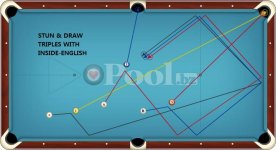CTE and BHE - Some Comments
BHE, or Aim & Pivot, is not an aiming system. I put it in this section as it's likely to stay within sight and won't annoy the majority who aren't interested in technical discussions.
BHE is more accurately a squirt cancellation system, with adjustments for swerve and sometimes throw.
CTE is an aiming system, which intends to align a player to a slight overcut, such that firm stun shots go to center pocket.
Coincidentally, the aim that I base all of my aim adjustments on, because I believe it allows the least amount of necessary adjustments on a wide range of shots, is a medium-firm naturally rolling pot, which is also a slight overcut of about 1/2 inch per yard for 3/4 ball pot.... or thereabouts.
When on this aim, a firm stun shot takes almost the same line, though as the cut angle gets bigger, the stun needs to be hit harder, or it starts throwing the pot a bit thick.
That said, we rarely stun shots that are wider than 30 degrees unless they are pretty close to a pocket.
My main point here however, is to explain why BHE methods will work well with anyone who has a method of aiming that takes them to a slight overcut.
However, there may be issues in adapting to the bridge length (pivot point) requirements of BHE.
If anyone has an issue or wants to deepen this area of discussion, please take it to PMs or another thread and I'll be happy to edit this post if valid points are forthcoming.
Respectfully,
Colin



